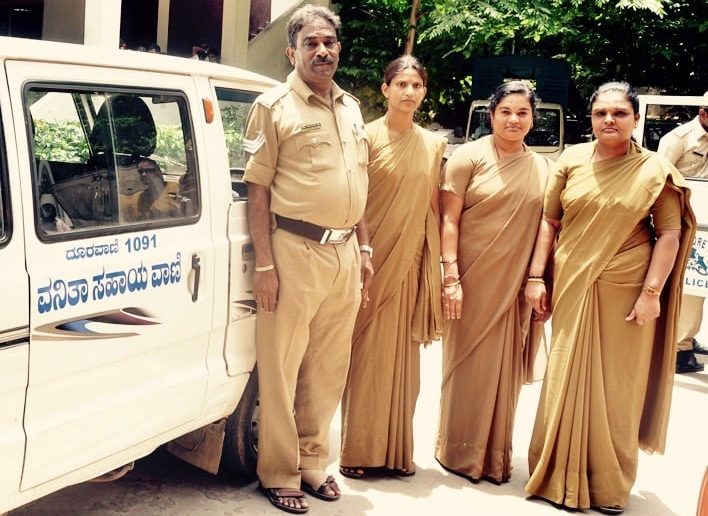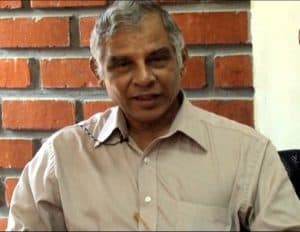
Women personnel constitute a minuscule percentage of Bengaluru’s police force. Pic credit: Bengaluru City Police
This article is part of a special series: Safety of women in Indian cities |
In any criminal act in which a woman is the target, the police is almost always in the best position to offer help, safety and reassurance to the aggrieved, besides investigating the crime and bringing the assailant to book. Clearly, this calls for a certain level of competence and professionalism, and a degree of empathy, patience and sensitivity towards women. Such qualities on the part of law-enforcers would be the criminal justice system’s most significant contribution towards empowering women and upholding their equal status.
Sadly however, while the law recognises and upholds gender equality, patriarchal mindsets do not. As more and more women are stepping out of their homes to claim what is rightfully theirs — half the world — we are seeing more and more frightful attacks on them. As disturbing as the attacks is the humiliating process of their seeking redressal from an insensitive force.
There has been much talk about gender-sensitisation of the police both from within and outside the police force. S T Ramesh, former DGP and IGP of Karnataka Police, was a reformer within the force. All through his service, be it as the person in charge of recruitment, training, prisons, forensics, and later as the head of the State police, Ramesh has tried to bring changes in the force’s attitude towards women’s issues. Excerpts from an exckusive chat with him:

S T Ramesh. Pic: Janaagraha/YouTube
Earlier surveys indicate that while only 30% of women share their experiences of harassment, only 1% of them report and pursue a case. What would you attribute that to?
Women across all societies are reluctant to share their harassment experiences for reasons which are well known. Women in India are much more reluctant in this regard. While societal issues, patriarchy and family pressure stop them from reporting the case to the police, one needs extraordinary patience and perseverance to negotiate the case through our problem-ridden criminal justice system. Getting an FIR registered in a police station is often the principle hurdle.
The challenge for a victim with respect to crime against women is manifold, not only on account of threats and intimidation by the accused but also owing to shaming and humiliation during the entire process of investigation, trial and appeal.The three recent rape cases in Unnao in UP are examples. Is it any surprise then, that only 1% of women come forward to file complaints and pursue the case?
A decade ago, in 2010, 13,000 policemen in Karnataka received gender sensitisation training. Had this shown results?
There is no doubt that gender sensitisation programme has made an impact on policemen by changing their attitudes towards women for the better. But this number constitutes a mere 13% of the strength of Karnataka police. Priority was given at that time to civil police at the Police Stations (PS) as they are the ones who deal with women complainants and victims at the PS.
The unique feature of the Karnataka model was that the resource persons were not police officers but members of civil society, committed to gender justice. This made a huge difference. It was based on a training module prepared imaginatively and painstakingly. The entire training was initially supported and supervised by UNICEF.
It is necessary to train the entire body of civil police and extend it to armed and KSRP personnel too. This would require greater resources, training infrastructure and resource persons. It’s very easy for the sensitised policemen to get desensitised during the rough and tumble of police duties, rotation of responsibilities and the ‘management by crisis’ nature of our PS. But then, many of the personnel who underwent training retired, or got promoted to higher ranks.So training has to be an ongoing process, include new entrants to the service and should be interspersed with frequent reorientation programmes.
That said, there is a need for gender sensitisation to be provided to every stake holder in the criminal justice system and in the society at large.
Nirbhaya happened in 2012. The national shock, anger and protest set off a number of government initiatives around women’s safety. Did it lead to any qualitative change in the police’s approach towards women’s safety?
The extent of national outrage caused by the ‘Nirbhaya case’ had a tremendous impact on the police. While the police always knew how sensitive ‘crimes against women’ as an issue was, the Nirbhaya case was a death blow to the image of the Indian police. Therefore, after Nirbhaya, senior echelons of the police department sent out appropriate signals to their subordinates. Priority was given for prevention and detection of crime against women. The rank and file also became prompter and more alert to crimes against women. Pink Hoysala patrol vehicles made their appearance.
But sadly, the Cyberabad incident and the rash of rape cases accompanied by violence in other parts of the country only showed that the Nirbhaya case has faded in memory. That only Rs 13.6 crore out of Rs 191 crore allotted for Nirbhaya funds have been utilised by Karnataka police and the fact that women personnel constitute a mere 6.11% of the state police suggest that the impact of the Nirbhaya case was only skin deep, and no concrete medium to long term plans have been made by the top brass in police to tackle crime against women.
Women from low-income families feel especially strongly about how unfriendly the police are towards them… what would you say about that?
Every member of the low income groups irrespective of gender feels the police is unfriendly , unhelpful and does not provide succour to them though it is their lawful duty. This is the perception across the board. It is because the Indian police has remained a colonial force and no attempt has been made to transform them into one suited for Democratic India. Such a transformation is possible only through comprehensive police reforms and those of the CJS. But the political class of this country since independence has miserably failed to give the citizens an efficient and a people friendly police. Internal reforms and good leadership can bring about improvement to some extent. But the big decisions on police and CJS reforms have to be taken by the State and Central governments.
Would a better male-female ratio in the police force make a difference in sensitising the department towards women’s issues?
That would definitely be one of the most important steps, notwithstanding the fact that some women in our society are more patriarchal than men and women’s safety can not be achieved merely by increasing the number of women police officers. I would go a step further and say that there should be no separate cadre of women police. There should be common recruitment of men and women police without any discrimination, of course with different physical standards and efficiency, as in the case of IPS/ IAS officers for example, or even First Division Assistants in the Government. This in my view will be the beginning of our effort to ensure that representation of women police is in proportion to their population in the community.
What are the causes for the low conviction rate in cases of rape and assault?
It is not as though there is a profusion of conviction in other categories of cases. Investigation of all cases are governed by the code of criminal procedure (CrPC) as far as procedures for investigation, prosecution ,trials and appeals are concerned, and by the Evidence Act (EA) with regard to evidence gathering, admissibility etc. These standards of procedure and evidence are often archaic, impractical and heavily tilted in favour of the accused. In the case of rape and assault, the cases are not only contested more keenly than others, the unreliable nature of oral evidence, the poor quality of forensic and medical evidence compound the problem leading to acquittals.
Delays are endemic to criminal trials. It is as though Criminal cases of all categories which reach the courts are put in one huge basket and taken up one by one chronologically for trial. Despite much talk of fast track and special courts there is no improvement. Delay seriously impacts the result of the case. Poor quality of investigation by police also result in acquittals.
I am wondering if the time has not come for a separate legislation for crime against women, on the lines of POCSO enacted in 2013 with modified procedures and standards of evidence and providing for in camera trials, imposing certain restrictions on cross examination of the victim during trials.
Are the forensic facilities and investigative expertise adequate?
The State Forensic Science Laboratory (SFSL)is neglected. It is in need of a massive reorganisation. The shortage of Scientific Assistants and Scientific Officers is acute. All talk of scientific investigation sounds hollow when we do not bother to upgrade the FSL.The four-tier structure of SFSL, Regional FSL, District and PS level forensic facility has to be created and provided with resources. There has to be a whole new focus on ‘crime scene’ management through specialised training of policemen in forensic science.
Woefully inadequate manpower and other resources in our police stations is a reality. Yet when it comes to poor quality of investigation of crimes against women, police cannot and should not take shelter under these shortfalls. Police will have to upgrade its investigative skills in rape cases and present a water tight case before a court. There is no escape from this. It has to be admitted that quality of investigation in rape cases should improve considerably.
Night shifts for women at workplaces – What does this call for?
It’s a huge statement. When women attend night shifts at work places many other things follow. There would be women cab drivers, women supervisors, women serving tea and coffee and so on. In fact, the more women are seen at work places, market places, roads, malls etc — both at night and during the day — the better it is for women’s safety.
And finally,the expression ‘zero tolerance’ is used very loosely and casually. It’s correct understanding should be as under:
- For the police it means that they act beyond the call of duty without ever giving constraints as reasons for inaction or failure or shoddy work;
- For Civil society, it means it does not blame the victim on any count irrespective of the circumstances of the rape;
- For the judiciary it means that they look for evidence to convict the accused and not acquit the case on technical grounds;
- For the political class zero tolerance means that they do not make bizarre statements to justify rapes.
- As regards other stakeholders, it means that they shun victim shaming and hold the rapist squarely responsible for his act.
When that sort of ‘zero tolerance’ is exhibited by every single stakeholder, it is bound to serve as a deterrent.